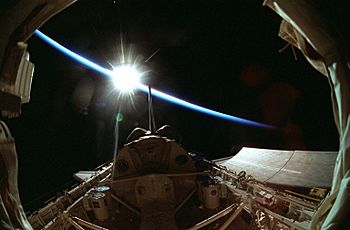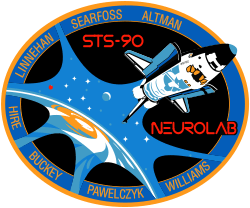STS-90 facts for kids
STS-90 was a special space mission in 1998. The Space Shuttle Columbia flew this mission. It lasted for 16 days. This mission was the last time the European Space Agency's Spacelab laboratory module flew into space. The Spacelab module had first flown on Columbia way back on STS-9. It was also the last time Columbia landed during the daytime.

Spacelab Module LM2 in Columbia's payload bay, serving as the Neurolab
|
|
| Mission type | Bioscience research |
|---|---|
| Operator | NASA |
| Mission duration | 15 days, 21 hours, 50 minutes, 58 seconds |
| Distance travelled | 10,000,000 kilometres (6,200,000 mi) |
| Spacecraft properties | |
| Spacecraft | Space Shuttle Columbia |
| Landing mass | 105,462 kilograms (232,504 lb) |
| Payload mass | 10,788 kilograms (23,783 lb) |
| Crew | |
| Crew size | 7 |
| Members |
|
| Start of mission | |
| Launch date | 17 April 1998 18:19 UTC |
| Launch site | Kennedy LC-39B |
| End of mission | |
| Landing date | 3 May 1998 16:09 UTC |
| Landing site | Kennedy SLF Runway 33 |
| Orbital parameters | |
| Reference system | Geocentric |
| Regime | Low Earth |
| Perigee | 247 kilometres (153 mi) |
| Apogee | 274 kilometres (170 mi) |
| Inclination | 39.0 degrees |
| Period | 89.7 min |
  Left to right – Front row: Altman, Searfoss; Back row: Pawelczyk, Linnehan, Hire, Williams, Buckey |
|
Contents
Meet the Astronauts
Seven astronauts flew on the STS-90 mission. They were a mix of experienced space travelers and some who were flying for the first time.
Main Crew Members
| Position | Astronaut | |
|---|---|---|
| Commander | Third and last spaceflight |
|
| Pilot | First spaceflight |
|
| Mission Specialist 1 | First spaceflight |
|
| Mission Specialist 2 | First spaceflight |
|
| Mission Specialist 3 | Second spaceflight |
|
| Payload Specialist 1 | Only spaceflight |
|
| Payload Specialist 2 | Only spaceflight |
|
Backup Crew Members
Sometimes, astronauts are trained as backups in case a main crew member cannot fly.
| Position | Astronaut | |
|---|---|---|
| Payload Specialist 1 | First spaceflight |
|
| Payload Specialist 2 | Second spaceflight |
|
Mission Goals: Studying the Brain in Space
The main goal of the STS-90 mission was to study how space affects the nervous system. This part of the mission was called Neurolab. Scientists wanted to learn how the brain and nerves adapt to living without gravity.
What is Neurolab?
Neurolab was a special laboratory module inside the Space Shuttle Columbia. It was designed to help scientists understand:
- How our balance system (vestibular system) changes in space.
- Why astronauts sometimes feel sick in space (space adaptation syndrome).
- How the brain controls our sense of where we are without gravity.
- How a developing nervous system is affected by microgravity.
Who Worked on Neurolab?
This mission was a huge team effort! Six space agencies and seven U.S. research agencies worked together. Scientists from nine different countries conducted 31 studies.
Some of the groups involved were:
- NASA (United States)
- CSA (Canada)
- ESA (Europe)
- Space agencies from France, Germany, and Japan.
- Several institutes from the National Institutes of Health in the U.S.
Experiments and Test Subjects
The Neurolab experiments focused on the nervous system, which is one of the most complex parts of our body. The scientists used different test subjects to see how microgravity affected them.
- Rats and mice
- Crickets and snails
- Two types of fish
- The astronauts themselves!
Most of these experiments took place in the large Spacelab module. This was the 16th and final planned flight for this specific Spacelab module. However, parts of the Spacelab system are still used on the International Space Station.
Unexpected Challenges
During the mission, there was a small problem with some baby rats. Many of them did not survive, which meant the Mammalian Development Team had to change their plans for some experiments.
Another challenge came up when a valve in the system that removes carbon dioxide from the air had a problem. The astronauts, with help from engineers on the ground, used aluminum tape to fix it! This clever repair kept the mission from ending early.
Other Cool Things on STS-90
Besides Neurolab, there were other experiments on board:
- The Shuttle Vibration Forces experiment, which studied how vibrations affect the shuttle.
- The Bioreactor Demonstration System-04, which tested a special container for growing cells.
- Three "Get-Away Special" (GAS) experiments, which are small, self-contained experiments.
STS-90 was also the first mission where the shuttle used its Orbital Maneuvering System (OMS) engines to help boost it into orbit during launch.
Astronauts on TV
Three of the STS-90 astronauts – Dafydd Williams, James Pawelczyk, and Jay Buckey – appeared on a Canadian TV show called Popular Mechanics for Kids. They shared their experiences from space!
First for Kennedy Space Center
Kathryn P. Hire, one of the mission specialists, was the very first employee from the Kennedy Space Center to be chosen as an astronaut. That's a big achievement!
A Bat on the Booster
Something very unusual happened during the launch of STS-90: a bat was seen on the solid rocket booster! Sadly, the bat did not survive the launch. A similar event happened during the STS-119 mission later on.

